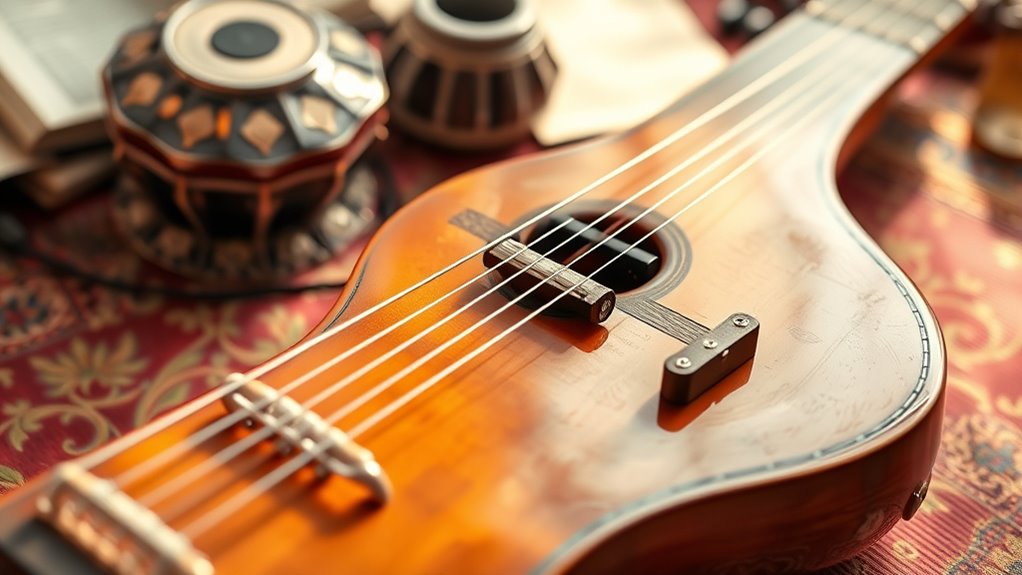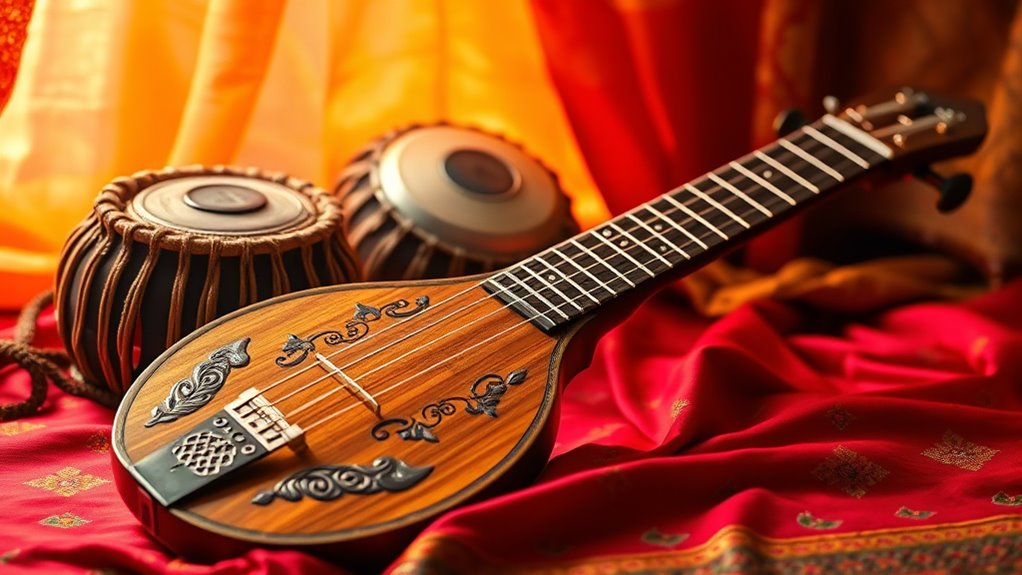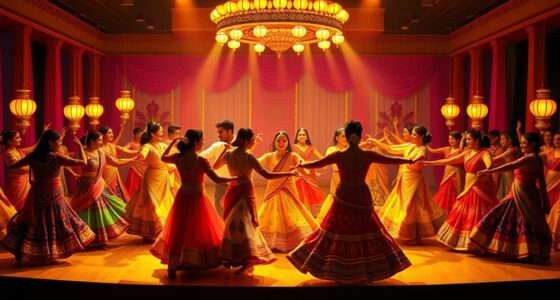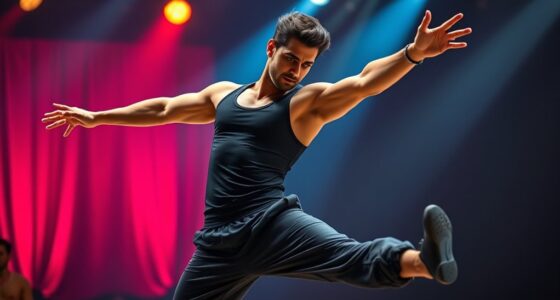Classical ragas form the melodic backbone of many Hindi film songs, helping you express emotions like love, longing, or joy. As a beginner, you should focus on understanding the basic scales, ornamentations, and mood of popular ragas like Bhairav, Yaman, or Kafi. These ragas evoke specific times of day and feelings, making your music more expressive. Keep exploring the nuances of each raga, and you’ll deepen your connection to their soulful essence.
Key Takeaways
- Many Hindi film songs are based on classical ragas to evoke specific moods like longing or devotion.
- Understanding basic raga structures and improvisation techniques helps in recognizing their use in films.
- Common ragas in movies include Bhimpalasi, Yaman, and Khamaj, each associated with particular feelings and times of day.
- Listening to classical performances enhances appreciation of how ragas convey emotion in film music.
- Learning about raga origins and characteristics deepens understanding of their emotional and spiritual influence in cinema.

If you’re new to Indian classical music, understanding ragas is essential to appreciating its depth and beauty. Ragas are the foundational melodic frameworks that give Indian music its soul, each with unique scales, moods, and times for performance. To truly grasp ragas and their origins, you should know that they evolved over centuries, blending spiritual, cultural, and musical traditions. Originally, ragas served as improvisational tools used by musicians to evoke specific feelings or seasons, and they continue to do so today. They aren’t just scales but complex structures that guide the performer through specific notes, ornamentations, and motifs, creating a distinctive atmosphere. Learning about ragas’ origins helps you appreciate their emotional and spiritual significance, which is often reflected in Hindi film music that uses these ragas to evoke particular moods like longing, joy, or devotion. Additionally, many ragas are associated with specific times of day, which influence their mood and the emotional response they evoke in listeners.
Once you understand the basics of ragas and their origins, you can start exploring basic improvisation techniques. Improvisation is central to Indian classical music, allowing musicians to express their creativity within the framework of a raga. A beginner should focus on mastering the alap, which is a slow, deliberate introduction where you explore the notes of the raga without rhythmic constraints. This is your chance to familiarize yourself with the mood and flavor of the raga through subtle ornamentations and microtones. As you progress, you’ll learn to develop the alaap into more rhythmic sections like the bandish or gat, where a fixed composition is set to a specific tala (rhythmic cycle). Here, improvisation becomes more lively, and you can experiment with variations, embellishments, and improvisational phrases that stay true to the raga’s character.
Practicing basic improvisation techniques helps you internalize the mood and structure of each raga. For example, you might start by repeating simple motifs or phrases within the raga’s scale, gradually adding ornamentations like gamakas (note oscillations) or meends (glides). It’s important to listen carefully to master musicians, noting how they emphasize certain notes or use specific ornamentations to evoke emotion. As you become more confident, you can try improvising within the boundaries of the raga, focusing on maintaining its essential mood while expressing your personal touch. Remember, improvisation in Indian classical music isn’t just about showcasing technical skill but about conveying the essence of the raga’s emotion, which is why understanding the origins and practicing these techniques will deepen your connection to the music and help you appreciate how filmmakers incorporate ragas into their songs to evoke specific feelings.
Frequently Asked Questions
How Do Ragas Influence the Emotional Tone of Hindi Film Songs?
You notice how ragas shape the emotional tone of Hindi film songs through their melodic influence. Each raga carries a specific mood, like serenity or longing, which evokes certain feelings in you. When composers choose a raga, they intentionally create a raga emotional tone that resonates with the scene’s mood. This melodic influence makes the song more expressive, helping you connect deeply with the story and characters.
Are There Specific Ragas Associated With Particular Seasons or Times of Day?
You’ll find that seasonal ragas and time-specific ragas are integral to classical music. For example, certain seasonal ragas evoke the mood of spring or monsoon, while time-specific ragas are performed at dawn, midday, or night to match the atmosphere. These ragas help you connect with nature’s rhythm, enhancing the emotional depth of a piece. By understanding these, you can appreciate how compositions align with the natural flow of the day and seasons.
Can Beginners Easily Identify Classical Ragas in Film Music?
You might think recognizing classical ragas in film music is like decoding an ancient secret, but it’s often more manageable than you imagine. With beginner listening skills, you’ll face some raga recognition challenges—like distinguishing subtle nuances. However, patience and practice can unseal this musical treasure chest. Start by focusing on melodies and instruments, and soon, you’ll surprise yourself by identifying ragas that once seemed hidden in plain sight!
What Are the Common Instruments Used to Perform Classical Ragas in Films?
You’ll notice that traditional instrument adaptations like sitar, tabla, and flute are common in film renditions of classical ragas. These instruments bring authentic sounds, but fusion music experiments often incorporate guitar, keyboard, or electronic instruments to appeal to modern audiences. This blend helps preserve the ragas’ essence while making the music more accessible, creating a unique sound that bridges classical traditions and contemporary styles.
How Has the Use of Ragas Evolved in Contemporary Hindi Cinema?
You’ll notice that in contemporary Hindi cinema, ragas have evolved through fusion genres and modern adaptations. Filmmakers blend traditional ragas with genres like pop, jazz, and electronic music, creating fresh sounds that appeal to younger audiences. This evolution preserves the essence of classical music while making it more accessible. As a result, ragas remain relevant, enriching film soundtracks with a unique blend of tradition and innovation.
Conclusion
Now that you’ve explored the roots of classical ragas in Hindi films, imagine the vibrant melodies weaving through a bustling city street—each note telling a story. Just like those busy lanes, ragas are timeless pathways connecting tradition with modern charm. Embrace this musical journey, and you’ll find that these ancient scales breathe life into every song, blending the old and new seamlessly. Let the melodies guide you, and your appreciation for Indian music will only deepen.









